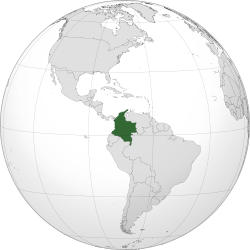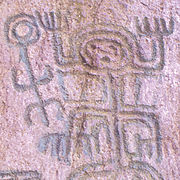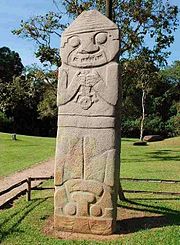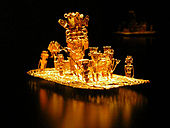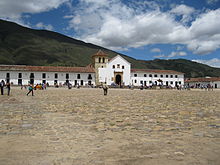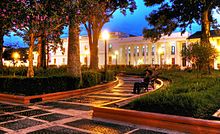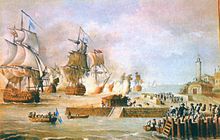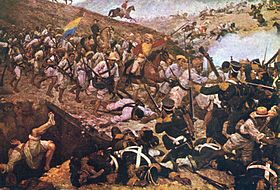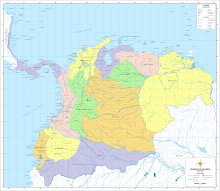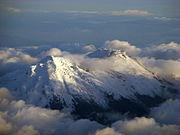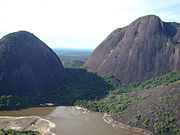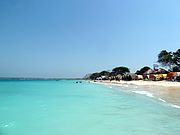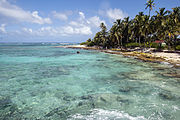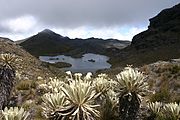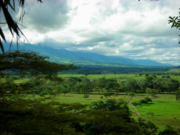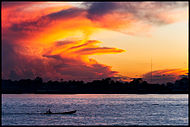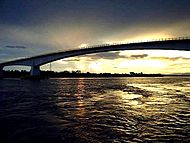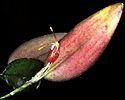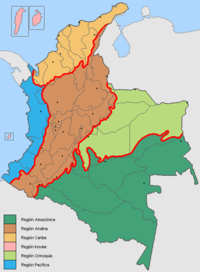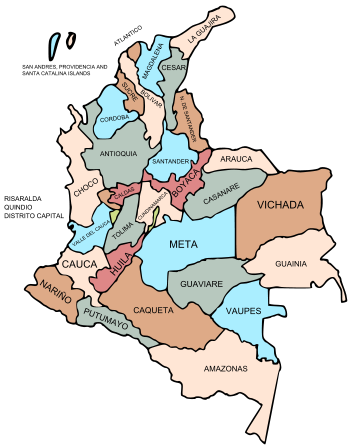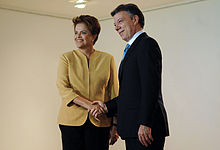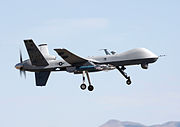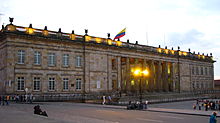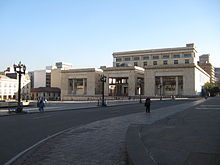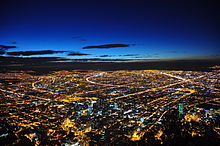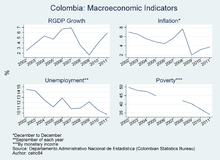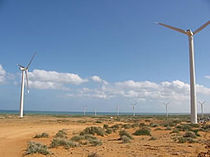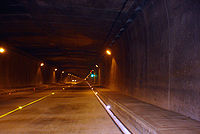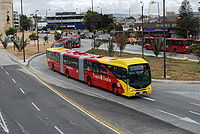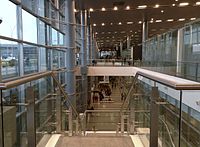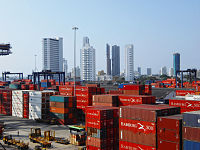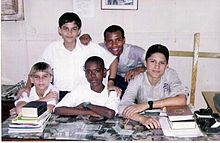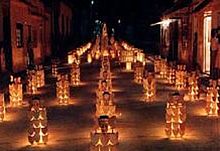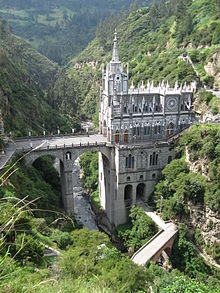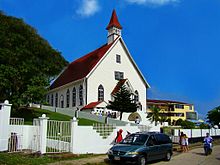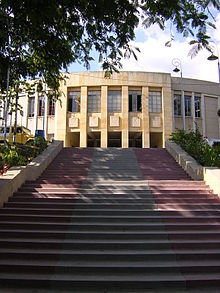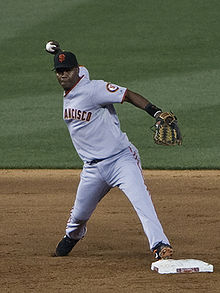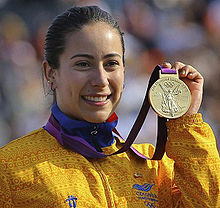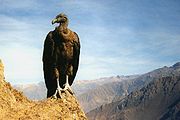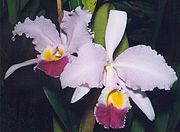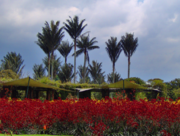
Colombia
Background Information
SOS Children have produced a selection of wikipedia articles for schools since 2005. Click here for more information on SOS Children.
| Republic of Colombia República de Colombia (Spanish)
|
||||||
|---|---|---|---|---|---|---|
|
||||||
| Motto: "Libertad y Orden" (Spanish) "Freedom and Order" |
||||||
| Anthem: ¡Oh, Gloria Inmarcesible! (Spanish) O unfading glory! |
||||||
|
|
||||||
| Capital and largest city |
Bogotá, D.C. 4°35′N 74°4′W |
|||||
| Official languages | Spanisha | |||||
| Recognised regional languages | 68 ethnic languages and dialects. English also official in the San Andrés and Providencia Islands. | |||||
| Ethnic groups () |
|
|||||
| Demonym | Colombian | |||||
| Government | Unitary presidential constitutional republic | |||||
| - | President | Juan Manuel Santos | ||||
| - | Vice President | Angelino Garzón | ||||
| Legislature | Congress | |||||
| - | Upper house | Senate | ||||
| - | Lower house | Chamber of Representatives | ||||
| Independence from Spain | ||||||
| - | Declared | 20 July 1810 | ||||
| - | Recognized | 7 August 1819 | ||||
| - | Current constitution | 4 July 1991 | ||||
| Area | ||||||
| - | Total | 1,141,748 km2 ( 26th) 440,831 sq mi |
||||
| - | Water (%) | 8.8 (17th) | ||||
| Population | ||||||
| - | February 2012 estimate | 47,072,915 ( 27th) | ||||
| - | 2005 census | 42,888,592 | ||||
| - | Density | 40.74/km2 ( 172nd) 105.72/sq mi |
||||
| GDP ( PPP) | 2012 estimate | |||||
| - | Total | $502.874 billion ( 28) | ||||
| - | Per capita | $10,791 | ||||
| GDP (nominal) | 2012 estimate | |||||
| - | Total | $366.020 billion ( 31) | ||||
| - | Per capita | $7,854 | ||||
| Gini (2012) | 53.9 high |
|||||
| HDI (2013) | high · 91st |
|||||
| Currency | Peso ( COP) |
|||||
| Time zone | COT ( UTC−5b) | |||||
| Date format | dd−mm−yyyy (CE) | |||||
| Drives on the | right | |||||
| Calling code | +57 | |||||
| ISO 3166 code | CO | |||||
| Internet TLD | .co | |||||
| a. | Although the Colombian Constitution specifies Spanish as the official language in all its territory, other languages spoken in the country (approximately 68 languages) are also official. English is also official in San Andrés and the Providencia Islands ( Consulta de la Norma. Alcaldiabogota.gov.co. Retrieved on 8 October 2012.) | |||||
| b. | The official Colombian time ( horalegal.sic.gov.co) is controlled and coordinated by the state agency Superintendency of Industry and Commerce. "Decreto 2153 de 1992, articulo 20" (in Spanish). Presidencia de la República de Colombia. Retrieved 13 October 2008. | |||||
Colombia ( / k ə ˈ l ʌ m b i ə / kə-LUM-biə, or / k ə ˈ l ɒ m b i ə / kə-LOM-biə), officially the Republic of Colombia (Spanish: República de Colombia [reˈpuβlika ðe koˈlombja]), is a unitary constitutional republic comprising thirty-two departments. It is located in northwestern South America, bordered to the northwest by Panama; to the north by the Caribbean Sea; to the east by Venezuela and Brazil; to the south by Ecuador and Peru; and to the west by the Pacific Ocean. Colombia is the 26th largest country by area and the fourth largest in South America. With over 46 million people, the country is the 27th largest in the world by population and has the second largest population of any Spanish-speaking country in the world, after Mexico. Colombia is a middle power, and is the fourth largest economy in Latin America, and the third largest in South America. The production of coffee, flowers, emeralds, textiles, industrial chemicals, plastics, ferro-alloys, coal, oil and financial services are the most representative sectors of Colombia's economy. Colombia is an emerging market and it is also part of the group of emerging countries CIVETS. The world's third biggest bank HSBC has created a perspective on the economic outlook in 2050 where Colombia is seen playing a decisive role in the global economy, especially in the Americas.
The territory of what is now Colombia was originally inhabited by indigenous peoples including the Muisca, Quimbaya, and Tairona. The Spanish arrived in 1499 and initiated a period of conquest and colonization ultimately creating the Viceroyalty of New Granada (comprising modern-day Colombia, Venezuela, Ecuador, north-western Brazil and Panama), with its capital at Bogotá. Independence from Spain was won in 1819, but by 1830 " Gran Colombia" had collapsed with the secession of Venezuela and Ecuador. What is now Colombia and Panama emerged as the Republic of New Granada. The new nation experimented with federalism as the Granadine Confederation (1858), and then the United States of Colombia (1863), before the Republic of Colombia was finally declared in 1886. Panama seceded in 1903. Colombia was the first constitutional government in South America, and an important promoter of the Pan American organizations, initially through the Congress of Panama and later as founder of the Organization of American States. The Liberal and Conservative parties, founded in 1848 and 1849, are two of the oldest surviving political parties in the Americas.
Colombia is ethnically diverse. The interaction between descendants of the original native inhabitants, Spanish colonists, African people originally brought to the country as slaves and 20th-century immigrants from Europe and the Middle East, have produced a varied cultural heritage. This has also been influenced by Colombia's varied geography. The majority of the urban centres are located in the highlands of the Andes mountains, but Colombian territory also encompasses Amazon rainforest, tropical grassland and both Caribbean and Pacific coastlines. Ecologically, Colombia is one of the world's 17 megadiverse countries, and is considered the most megadiverse per square kilometer. Colombia is considered a strong performer of the EPI (Environmental Performance Indicator) policies.
Since the 1960s, government forces, left-wing insurgents and right-wing paramilitaries have been engaged in the continent's longest-running armed conflict. This escalated dramatically from the mid-1980s to the late 1990s. Between 2000 and 2005 the violence decreased significantly, with some paramilitary groups demobilizing as part of a controversial peace process and the guerrillas losing control of much of the territory they once dominated.
Etymology

The name "Colombia" is derived from the last name of Christopher Columbus (Italian: Cristoforo Colombo; Spanish: Cristóbal Colón). It was conceived by the Venezuelan revolutionary Francisco de Miranda as a reference to all the New World, but especially to those under the Spanish and Portuguese rule. The name was later adopted by the Republic of Colombia of 1819, formed out of the territories of the old Viceroyalty of New Granada (modern-day Colombia, Panama, Venezuela, Ecuador, and northwest Brazil).
In 1835, when Venezuela and Ecuador parted ways, the Cundinamarca region that remained became a new country – the Republic of New Granada. In 1858 the New Granada officially changed its name to the Granadine Confederation, then in 1863 the United States of Colombia, before finally adopting its present name – the Republic of Colombia – in 1886.
To refer to the country, the Colombian government uses the terms Colombia and República de Colombia.
History
Prehistory
Due to its geographical location, the present territory of Colombia was a corridor of populations between Mesoamerica, the Caribbean, the Andes and the Amazon. The oldest archaeological finds are from sites at Monsú and Pubenza, dating from about 20,000 BC. Other vestiges indicate that there was also early occupation in regions like El Abra between Tocancipá, Zipaquirá and Tequendama in Cundinamarca. These sites correspond to the Paleoindian period. In Puerto Hormiga, traces of the archaic period have been found, including the oldest pottery discovered in America, dating from about 3000 BC.
Pre-Columbian
Approximately 10,000 BC, the territory of what is now Colombia was inhabited by indigenous people including the Muisca, Quimbaya, and Tairona. Hunter-gatherer societies existed near present-day Bogotá (at "El Abra" and "Tequendama") which traded with one another and with cultures living in the Magdalena River Valley. Beginning in the 1st millennium BC, groups of Amerindians developed the political system of " cacicazgos" with a pyramidal structure of power headed by caciques. The Muiscas inhabited mainly the area of what is now the Departments of Boyacá and Cundinamarca high plateau ( Altiplano Cundiboyacense). They farmed maize, potato, quinoa and cotton, and traded worked gold, emeralds, blankets, ceramic handicrafts, coca and salt with neighboring nations. The Taironas inhabited northern Colombia in the isolated Andes mountain range of Sierra Nevada de Santa Marta.
Spanish conquest (1499–1525 AD)
Spanish explorers, led by Rodrigo de Bastidas, made the first exploration of the Caribbean littoral in 1500. Christopher Columbus navigated near the Caribbean in 1502. In 1508, Vasco Núñez de Balboa started the conquest of the territory through the region of Urabá. In 1513, he was the first European to see the Pacific Ocean, which he called Mar del Sur (or "Sea of the South") and which in fact would bring the Spaniards to Peru and Chile.
Alonso de Ojeda (who had sailed with Columbus) reached the Guajira Peninsula in 1500. Santa Marta was founded in 1525, and Cartagena in 1533. Gonzalo Jiménez de Quesada led an expedition to the interior in 1535, and founded the "New City of Granada", the name of which soon changed to "Santa Fé". Two other notable journeys by Spaniards to the interior took place in the same period. Sebastian de Belalcazar, conqueror of Quito, traveled north and founded Cali, in 1536, and Popayán, in 1537; Nicolas Federman crossed the Llanos Orientales and went over the Eastern Cordillera.
The Caribbean people, indigenous to Colombia, experienced a reduction in population due to conquest by the Spanish as well as European-carried diseases such as smallpox, to which they had no immunity. In the 16th century, Europeans began to bring slaves from Africa.
Colonial times (1525–1808)
The Spanish settled along the north coast of today's Colombia as early as the 16th century, but their first permanent settlement, at Santa Marta, was not established until 1525. In 1549, the institution of the Audiencia in Santa Fe de Bogotá gave that city the status of capital of New Granada, which comprised in large part what is now territory of Colombia.
With the risk that the land was deserted, the Spanish Crown sold properties to the governors, conquerors and their descendants creating large farms and possession of mines. Slaves were introduced as labor. Also to protect the indigenous population decimated, and Indian reservations were created. The repopulation was achieved by allowing colonization by farmers and their families who came from Spain. With this began the colonial period. New Granada was ruled by the Royal Audience of Santa Fe de Bogotá, but important decisions were taken to the colony from Spain by the Council of the Indies.
A royal decree of 1713 approved the legality of Palenque de San Basilio founded by runaway slaves from the 15th century, slaves had fled and sought refuge in the jungles of the Caribbean coast. The Spanish forces could not tolerate them and ended up submitting, thereby giving rise to the first free place in the Americas. Its main leader was Benkos Biohó, born in the region Bioho, Guinea Bissau, West Africa. Palenque de San Basilio was declared in 2005 as a "Masterpiece of Oral and Intangible Heritage of Humanity" by UNESCO.
In 1717 the Viceroyalty of New Granada was originally created, and then it was temporarily removed, to finally be reestablished in 1739. The Viceroyalty had Santa Fé de Bogotá as its capital. This Viceroyalty included some other provinces of northwestern South America which had previously been under the jurisdiction of the Viceroyalties of New Spain or Peru and correspond mainly to today's Venezuela, Ecuador and Panama. So, Bogotá became one of the principal administrative centers of the Spanish possessions in the New World, along with Lima and Mexico City, though it remained somewhat backward compared to those two cities in several economic and logistical ways.
The 18th-century priest, botanist and mathematician José Celestino Mutis (1732–1808), was delegated by the viceroy Antonio Caballero y Góngora to conduct an inventory of the nature of the New Granada. This became known as the Royal Botanical Expedition to New Granada which classified plants, wildlife and founded the first astronomical observatory in the city of Santa Fe de Bogotá. On 15 August 1801 the Prussian scientist Alexander von Humboldt reached Fontibón where he joined Mutis in New Granada expedition to Quito.
Independence from Spain (1808–1824)
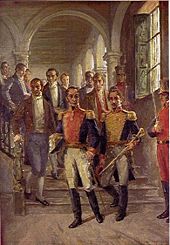
Since the beginning of the periods of conquest and colonization, there were several rebel movements under Spanish rule, most of them were either crushed or remained too weak to change the overall situation. The last one which sought outright independence from Spain sprang up around 1810, following the independence of St. Domingue (present-day Haiti) in 1804, which provided a non-negligible degree of support to the eventual leaders of this rebellion: Simón Bolívar and Francisco de Paula Santander.
A movement initiated by Antonio Nariño, who opposed Spanish centralism and led the opposition against the viceroyalty, led to the independence of Cartagena in November 1811, and the formation of two independent governments which fought a civil war – a period known as La Patria Boba. The following year Nariño proclaimed the United Provinces of New Granada, headed by Camilo Torres Tenorio. Despite the successes of the rebellion, the emergence of two distinct ideological currents among the liberators (federalism and centralism) gave rise to an internal clash which contributed to the reconquest of territory by the Spanish. The viceroyalty was restored under the command of Juan de Samano, whose regime punished those who participated in the uprisings. The retribution stoked renewed rebellion, which, combined with a weakened Spain, made possible a successful rebellion led by the Venezuelan-born Simón Bolívar, who finally proclaimed independence in 1819. The pro-Spanish resistance was finally defeated in 1822 in the present territory of Colombia and in 1823 in Venezuela.
The territory of the Viceroyalty of New Granada became the Republic of Colombia organized as a union of Ecuador, Colombia and Venezuela (Panama was then an integral part of Colombia). The Congress of Cúcuta in 1821 adopted a constitution for the new Republic. Simón Bolívar became the first President of Colombia, and Francisco de Paula Santander was made Vice President. However, the new republic was unstable and ended with the rupture of Venezuela in 1829, followed by Ecuador in 1830.
Post-independence and republicanism (1824–1930)
Colombia was the first constitutional government in South America, and the Liberal and Conservative parties, founded in 1848 and 1849 respectively, are two of the oldest surviving political parties in the Americas.
Internal political and territorial divisions led to the secession of Venezuela and Quito (today's Ecuador) in 1830. The so-called " Department of Cundinamarca" adopted the name " Nueva Granada", which it kept until 1856 when it became the "Confederación Granadina" ( Granadine Confederation). After a two-year civil war in 1863, the " United States of Colombia" was created, lasting until 1886, when the country finally became known as the Republic of Colombia. Internal divisions remained between the bipartisan political forces, occasionally igniting very bloody civil wars, the most significant being the Thousand Days' War (1899–1902).
This, together with the United States of America's intentions to influence the area (especially the Panama Canal construction and control) led to the separation of the Department of Panama in 1903 and the establishment of it as a nation. The United States paid Colombia $25,000,000 in 1921, seven years after completion of the canal, for redress of President Roosevelt's role in the creation of Panama, and Colombia recognized Panama under the terms of the Thomson-Urrutia Treaty. Colombia was engulfed in the Year-Long War with Peru over a territorial dispute involving the Amazonas Department and its capital Leticia.
The Violence and the National Front (1930–1974)
Soon after, Colombia achieved some degree of political stability, which was interrupted by a bloody conflict that took place between the late 1940s and the early 1950s, a period known as La Violencia ("The Violence"). Its cause was mainly mounting tensions between the two leading political parties, which subsequently ignited after the assassination of the Liberal presidential candidate Jorge Eliécer Gaitán on 9 April 1948. The ensuing riots in Bogotá, known as El Bogotazo, spread throughout the country and claimed the lives of at least 180,000 Colombians.
From 1953 to 1964 the violence between the two political parties decreased first when Gustavo Rojas deposed the President of Colombia in a coup d'état and negotiated with the Guerrillas, and then under the military junta of General Gabriel París Gordillo.
After Rojas' deposition, the Colombian Conservative Party and Colombian Liberal Party agreed to create the " National Front", a coalition which would jointly govern the country. Under the deal, the presidency would alternate between conservatives and liberals every 4 years for 16 years; the two parties would have parity in all other elective offices. The National Front ended "La Violencia", and National Front administrations attempted to institute far-reaching social and economic reforms in cooperation with the Alliance for Progress. In the end, the contradictions between each successive Liberal and Conservative administration made the results decidedly mixed. Despite the progress in certain sectors, many social and political problems continued, and guerrilla groups were formally created such as the FARC, ELN and M-19 to fight the government and political apparatus.
Constitution of 1991
The political history of Colombia broke in two on July 4 of 1991, when the new Political Constitution was promulgated.
The new Constitution began to guarantee the freedom of worship and religion, gender equity for women, the free development of the personality, the freedom of expression and information, the protection of the rights of women, children and elderly, the integral protection of the family and their rights, the defence of nature and the environment, the establishment of mechanisms of citizen participation to decision making in the politics, the creation of the tutela action which is the mechanism that has a citizen to claim immediate protection of their fundamental rights, when these are infringed or threatened. These are just some of the many changes generated in Colombia thanks to the new Constitution and that are viewed as positive changes within the Government by the Colombian society.
Colombian armed conflict, 2002 – present
.
The armed conflict in Colombia is very complex and there is a debate about the causes of the conflict. Although today is understood that the conflict is rooted in a combination of causes that are based on the economic, political and social situation in the country 50 years ago.
In the beginning the early activity (1974-1982) of guerrilla groups like the FARC, the ELN and others was focused on his slogans of the pursuit of greater equality and economic development in the country for this reason they came to have support from some sections of the local population. However, the armed action changed since the mid-1980s when Colombia granted greater political independence and strengthened fiscal policy of local governments, that is why the Colombian Government strengthened its institutional presence in the country.
After the Colombian Government managed to successfully dismantle the drug cartels that appeared in the country during the 1980s, left-wing guerrilla groups and rightwing paramilitary organizations resumed some activities of drug cartels dismantled such as cocaine production with destination to the United States and Europe and also these groups began to be financed through extortion and kidnapping. These facts led to left-wing guerrilla groups and rightwing paramilitary organizations to lose support of the population sectors involved in the conflict and increased hatred towards them for their actions since the Colombian people rejects the illegal activities, violations of human rights and violence.
During the presidency of Álvaro Uribe, the government applied more military pressure on the FARC and other outlawed groups. After the offensive, supported by aid from the United States, many security indicators improved. Although Colombia has covered between 85%-100% of its defense bill and for this reason, most of the resources have been provided by Colombia. Colombia with a strong anti-narcotic strategy has fought against groups responsible for the production of cocaine as the FARC, achieving a great decrease in cocaine production, thanks to this, White House drug czar R. Gil Kerlikowske announced that Colombia is no longer the world's biggest producer of cocaine. Cocaine manufactured by rebel groups was historically mostly consumed in the USA and Europe, the United States of America is still the world's largest consumer of cocaine. The drug trade has ruined many innocent citizens' lives in Colombia.
- left-wing guerrilla groups as the FARC were militarily trained and advised on the development of explosives by terrorist groups such as the Spanish terrorist organization ETA and the Irish terrorist organization IRA.
Achievements of Colombia in this decade:
- The Colombian Government made significant progress in the institutional presence of the Colombian State, which include military aspects and security.
- The Colombian Government began to overcome many of their mistakes in the past, for this reason, education has been improved, and Colombia is creating an economy that is today considered attractive and prosperous by many national and international investors.
- The overall reduction of violence led to the growth of internal travel and tourism.
Some important events in this part of the history of the armed conflict in Colombia:
- In February 2008, in an unprecedented event, millions of Colombians take to the streets to demonstrate against the FARC in a global movement called "One Million Voices Against FARC." The Colombian people says that the FARC have lied to the world with their supposed fight, since the FARC no longer have any ideology but a disproportionate capitalist ambition that threatens Colombian citizens.
- More than 15,770 FARC and ELN combatants have decided to demobilize since 2002 due to the strong military pressure exerted by the security forces of Colombia and the loss of true Communist values within the rebel groups. Ex-combatants of the rebel groups have said that the FARC and the ELN have lost their Communist values, the rebel groups only commit serious violations of human rights.
- The FARC's commander in chief Alfonso Cano was killed by security forces of Colombia in November 2011. He was replaced by Timoleón Jiménez, who assumed the duty of first commander just days after Cano's death. Colombia security forces also killed the leader of the smaller rebel group ELN during a military operation.
- The United States of America has been heavily involved in the conflict since its beginnings, when in the early 1960s the U.S. government pushed the Colombian military to attack peasant self-defense communities in rural Colombia. This was part of the U.S. fight against communism. The position of the USA within the armed conflict in Colombia has been criticized by various organizations in the world.
- In 2011, the National Administrative Department of Statistics (DANE) reported that 34% of Colombians were living below the poverty line and 10.6% in "extreme poverty" which means that poverty has been reduced. 1.2 million Colombians have been lifted out of poverty while 674,000 ceased to be indigent. Although there are economic disparities, the Government of Colombia has begun to walk the path to poverty reduction.
- In 2012, the Colombian Government launched a strong policy that includes the construction and the delivery of 100,000 decent houses for free for poor people, a subsidy for to reduce the digital divide between rich and poor and the restitution of land for local farmers displaced by the violence. President Juan Manuel Santos said he wants a Colombia and a Latin America free of poverty.
- While the levels of poverty and violence have gone down in the country. In recent years, economic growth has led to a considerable increase of new millionaires, 1.8 million adult Colombians are now newly rich. Colombia was the nation where private wealth grew more between June 2011 and June 2012, according to Credit Suisse. In the country have increased the number of Colombian entrepreneurs on the list of the richest people on the planet with net worth exceeding $ 1 billion. Although this does not mean that the entire population has improved their economic situation, it is clear that there is a new economic dynamic in Colombia.
Peace process in Colombia, 2012 – present
The Peace process in Colombia, 2012 refers to the dialogue between the Colombian government and guerrilla of FARC-EP with the aim to find a political solution to the armed conflict. The Colombian government and rebel groups meet in Cuba. Talks have been positive and represent breakthroughs that comprise end the conflict.
Recent developments
Colombia shows modest progress in the struggle to defend human rights, as expressed by HRW. In terms of international relations, Colombia has moved from a period of tense animosity with Venezuela, towards a prosperous outlook to further enhance integration. Colombia has also won a seat on the Security Council of the UN.
Today Colombia is the third largest oil producer in South America and it is estimated that by 2012, Colombia will be producing a million barrels a day.
Geography
The geography of Colombia is characterized by its six main natural regions that present their own unique characteristics, from the Andes mountain range region shared with Ecuador and Venezuela; the Pacific coastal region shared with Panama and Ecuador; the Caribbean coastal region shared with Venezuela and Panama; the Llanos (plains) shared with Venezuela; to the Amazon Rainforest region shared with Venezuela, Brazil, Peru and Ecuador. Colombia is the country in the planet more characterized by a high biodiversity, with the highest rate of species by area unit worldwide and it has the largest number of endemisms (species that are not found naturally anywhere else) of any country. About 10% of the species of the Earth live in Colombia, including over 1800 species of bird, more than in Europe and North America combined, and it hosts 456 species of mammal, more than any other country in the world. It is the only South American country which borders both the Atlantic and Pacific Oceans.
Colombia is bordered to the east by Venezuela and Brazil; to the south by Ecuador and Peru; to the north by Panama and the Caribbean Sea; and to the west by Ecuador and the Pacific Ocean. Including its Caribbean islands, it lies between latitudes 14°N and 5°S, and longitudes 66° and 82°W
Part of the Ring of Fire, a region of the world subject to earthquakes and volcanic eruptions, Colombia is dominated by the Andes (which contain the majority of the country's urban centres). Beyond the Colombian Massif (in the south-western departments of Cauca and Nariño) these are divided into three branches known as cordilleras (mountain ranges): the Cordillera Occidental, running adjacent to the Pacific coast and including the city of Cali; the Cordillera Central, running between the Cauca and Magdalena river valleys (to the west and east respectively) and including the cities of Medellín, Manizales, Pereira and Armenia; and the Cordillera Oriental, extending north east to the Guajira Peninsula and including Bogotá, Bucaramanga and Cúcuta. Peaks in the Cordillera Occidental exceed 13,000 ft (3,962 m), and in the Cordillera Central and Cordillera Oriental they reach 18,000 ft (5,486 m). At 8,500 ft (2,591 m), Bogotá is the highest city of its size in the world.
East of the Andes lies the savanna of the Llanos, part of the Orinoco River basin, and, in the far south east, the jungle of the Amazon rainforest. Together these lowlands comprise over half Colombia's territory, but they contain less than 3% of the population. To the north the Caribbean coast, home to 20% of the population and the location of the major port cities of Barranquilla and Cartagena, generally consists of low-lying plains, but it also contains the Sierra Nevada de Santa Marta mountain range, which includes the country's tallest peaks ( Pico Cristóbal Colón and Pico Simón Bolívar), and the La Guajira Desert. By contrast the narrow and discontinuous Pacific coastal lowlands, backed by the Serranía de Baudó mountains, are sparsely populated and covered in dense vegetation. The principal Pacific port is Buenaventura.
Colombian territory also includes a number of Caribbean and Pacific islands. This is considered by some as a sixth region, comprising those areas outside continental Colombia, including the department of San Andrés y Providencia in the Caribbean Sea and the islands of Malpelo and Gorgona in the Pacific Ocean. However, cultural ties are with the respective coastlines.
Hydrology and climate
The hydrography of Colombia is one of the richest in the world. Its main rivers are Magdalena, Cauca, Guaviare, and Caquetá. Colombia has four main drainage systems: the Pacific drain, the Caribbean drain, the Orinoco Basin and the Amazon Basin. The Orinoco and Amazon Rivers mark limits with Colombia to Venezuela and Peru respectively.
The striking variety in temperature and precipitation results principally from differences in elevation. Temperatures range from very hot at sea level to relatively cold at higher elevations but vary little with the season. Temperatures generally decrease about 3.5° F (2°C) for every 1,000-ft (300-m) increase in altitude above sea level, presenting perpetual snowy peaks to hot river valleys and basins. Rainfall is concentrated in two wet seasons (roughly corresponding to the spring and autumn of temperate latitudes) but varies considerably by location. Colombia's Pacific coast has one of the highest levels of rainfall in the world, with the south east often drenched by more than 200 in (500 cm) of rain per year. On the other hand rainfall in parts of the Guajira Peninsula seldom exceeds 30 in (75 cm) per year. Rainfall in the rest of the country runs between these two extremes.
Colombians customarily describe their country in terms of the climatic zones. Below 900 meters (2,953 ft) in elevation is the tierra caliente (hot land), where temperatures vary between 24 and 38 °C (75.2 and 100.4 °F). The most productive land and the majority of the population can be found in the tierra templada (temperate land, between 900 and 1,980 meters (2,953 and 6,496 ft)), which provide the best conditions for the country's coffee growers, and the tierra fría (cold land, 1,980 and 3,500 meters (6,496 and 11,483 ft)), where wheat and potatoes dominate. In the tierra fría mean temperatures range between 10 and 19 °C (50 and 66.2 °F). Beyond the tierra fría lie the alpine conditions of the zona forestada (forested zone) and then the treeless grasslands of the páramos. Above 4,500 meters (14,764 ft), where temperatures are below freezing, is the tierra helada, a zone of permanent snow and ice.
About 86% of the country's total area lies in the tierra caliente. Included in this, and interrupting the temperate area of the Andean highlands, are the long and narrow extension of the Magdalena Valley and a small extension in the Cauca Valley. The tierra fría constitutes just 6% of the total area, but supports about a quarter of the country's population.
Biodiversity
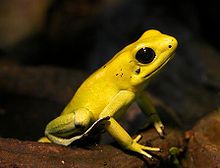
Colombia has a large number of taxonomic groups animals and flora typical equator which is, in addition to varieties of migrations wildlife from around the world. Colombia is one of the megadiverse countries in biodiversity, ranking third in living species and first in bird species. As for plants, the country has between 40,000 and 45,000 plant species, equivalent to 10 or 20% of total global species, considered very high for a country of intermediate size. In total, Colombia is the second most biodiverse country in the world, after Brazil.
Colombia also has about 2,000 species of marine fish and 1,435 species of freshwater fish. Colombia is the country with more endemic species of butterflies: 3,272 species and more than 250,000 varieties of beetles. First in amphibian species, with 30% of the species of turtles and 25% of the species of crocodiles. There are 34 species of primates, 270 species of snakes and according to estimates there are about 300,000 species of invertebrates in the country. In Colombia there are 32 terrestrial biomes and 314 types of ecosystems.
National system of protected areas
Colombia has 56 protected areas under the protection of "National System of Protected Areas" (SINAP) administered by the Ministry of Environment, Housing and Territorial Development. It also has a "National Park System". These areas cover an area of about 12,602,320.7 hectares (126,023.21 square kilometers) and account for more than 11.04% of the Colombian mainland which testify to the richness and biodiversity of the country and are in the Andean Region, 26 (in the Knot of the Pastos, 2, in the West Andes, 5, in the Central Andes, 7, and in the East Andes, 12), in the Caribbean Region, 9, in the Orinoquía, 2, in the Amazon, 12, on the Pacific Coast, 4, and finally, in the Islands, 3. The areas are classified as: Natural National Parks (41), Fauna and Flora Sanctuary (11), Natural National Reserves (2), Road park (1) and Unique Natural Area (1).
Natural regions
Because of its natural structure, Colombia can be divided into six very distinct natural regions.
- Amazon Region: Comprises the part South of the eastern region of Colombia, flat low-lying region. It is the region of the Amazon jungle of Colombia.
- Andean Region: The Colombian part of the Andes, including inter-Andean valleys them of the rivers Cauca and Magdalena.
- Caribbean Region: The region of the Colombian Caribbean coastal plains and mountainous groups which do not belong to the Andes as the Sierra Nevada de Santa Marta.
- Insular Region: comprises the areas outside the continental territories of Colombia in the Caribbean region as the islands of San Andrés and Providencia and the islands of Gorgona and Malpelo in the Pacific Ocean.
- Orinoquía Region: North of the eastern region of Colombia that belongs to the Orinoco River watershed, flat low-lying region. Also known colloquially as the Eastern Plains.
- Pacific Region: It includes the coastal plains of the pacific coast and the mountainous groups which do not belong to the Andes, in particular the Serranía del Baudó.
Environmental issues
The environmental challenges faced by Colombians are caused by both natural and human factors. Many natural hazards result from the geological instability related to Colombia's position along the Pacific Ring of Fire. Colombia has 15 major volcanoes, the eruptions of which have on occasion resulted in substantial loss of life, such as at Armero in 1985. Geological faults that have caused numerous devastating earthquakes, such as the 1999 Armenia earthquake. Heavy floods both in mountainous areas and in low-lying watersheds and coastal regions regularly cause deaths and considerable damage to property during the rainy seasons. Rainfall intensities vary with the El Niño-Southern Oscillation which occurs in unpredictable cycles, at times causing especially severe flooding.
Human induced deforestation has started to creep into the rainforests of Amazonia and the Pacific coast and has substantially changed the Andean landscape. Deforestation is also linked to the conversion of lowland tropical forests to palm oil plantations. However, compared to neighboring countries rates of deforestation in Colombia are still relatively low. In urban areas, contamination of the local environment has been caused by human produced waste, and the use of fossil fuels. Participants in the country's armed conflict have also contributed to the pollution of the environment. Illegal armed groups have deforested large areas of land to plant illegal crops, with an estimated 99,000 hectares used for the cultivation of coca in 2007, while in response the government has fumigated these crops using hazardous chemicals. Insurgents have also destroyed oil pipelines creating major ecological disasters. Demand from rapidly expanding cities has placed increasing stress on the water supply as watersheds are affected and ground water tables fall. Nonetheless, Colombia is the fourth country in the world by magnitude of total freshwater supply, and still has large reserves of freshwater.
Government and politics
The government of Colombia takes place within the framework of a presidential representative democratic republic as established in the Constitution of 1991. In accordance with the principle of separation of powers, government is divided into three branches: the executive branch, the legislative branch and the judicial branch.
As the head of the executive branch, the President of Colombia serves as both head of state and head of government, followed by the Vice President and the Council of Ministers. The president is elected by popular vote to serve four-year terms and is limited to a maximum of two such terms (increased from one in 2005). At the provincial level executive power is vested in department governors, municipal mayors and local administrators for smaller administrative subdivisions, such as corregidores or corregimientos.
The legislative branch of government is represented nationally by the Congress, a bicameral institution comprising a 166-seat Chamber of Representatives and a 102-seat Senate. The Senate is elected nationally and the Chamber of Representatives by every region and minority groups. Members of both houses are elected to serve four-year terms two months before the president, also by popular vote. At the provincial level the legislative branch is represented by department assemblies and municipal councils. All regional elections are held one year and five months after the presidential election.
The judicial branch is headed by the Supreme Court, consisting of 23 judges divided into three chambers (Penal, Civil and Agrarian, and Labour). The judicial branch also includes the Council of State, which has special responsibility for administrative law and also provides legal advice to the executive, the Constitutional Court, responsible for assuring the integrity of the Colombian constitution, and the Superior Council of Judicature, responsible for auditing the judicial branch. Colombia operates a system of civil law, which since 2005 has been applied through an adversarial system.
Administrative divisions
Click on a department on the map below to go to its article.
|
Colombia is divided into 32 departments and one capital district, which is treated as a department (Bogotá also serves as the capital of the department of Cundinamarca). Departments are subdivided into municipalities, each of which is assigned a municipal seat, and municipalities are in turn subdivided into corregimientos. Each department has a local government with a governor and assembly directly elected to four-year terms. Each municipality is headed by a mayor and council, and each corregimiento by an elected corregidor, or local leader.
In addition to the capital nine other cities have been designated districts (in effect special municipalities), on the basis of special distinguishing features. These are Barranquilla, Cartagena, Santa Marta, Cúcuta, Popayán, Bucaramanga, Tunja, Turbo, Buenaventura and Tumaco. Some departments have local administrative subdivisions, where towns have a large concentration of population and municipalities are near each other (for example in Antioquia and Cundinamarca). Where departments have a low population (for example Amazonas, Vaupés and Vichada), special administrative divisions are employed, such as "department corregimientos", which are a hybrid of a municipality and a corregimiento.
Foreign affairs
The foreign affairs of Colombia are headed by the President, as head of state, and managed by the Minister of Foreign Affairs. Colombia has diplomatic missions in all continents and is also represented in multilateral organizations at the following locations:
- Brussels (Mission to the European Union)
- Geneva (Permanent Missions to the United Nations and other international organizations)
- Montevideo (Permanent Missions to the Latin American Integration Association and Mercosur)
- Nairobi (Permanent Missions to the United Nations and other international organizations)
- New York (Permanent Mission to the United Nations)
- Paris (Permanent Mission to UNESCO)
- Rome (Permanent Mission to the Food and Agriculture Organization)
- Washington, D.C. (Permanent Mission to the Organization of American States)
Colombia was one of the 12 founding members of the UNASUR, which is supposedly modeled on the European Union having free trade agreements between the members, free movement of people, a common currency, and also a common passport. Colombia is a member of the Andean Community of Nations, the Pacific Alliance and the Union of South American Nations.
Military
The executive branch of government is responsible for managing the defense of Colombia, with the President commander-in-chief of the armed forces. The Ministry of Defence exercises day-to-day control of the military and the Colombian National Police. According to UN Human Development Report criteria, Colombia has 209,000 military personnel, and in 2005 3.7% of the country's GDP went towards military expenditure, both figures placing it 21st in the world. Within Latin America, Colombia's armed forces are the third-largest, behind Brazil and Mexico, and it spends the second-highest proportion of GDP after Chile.
The Colombian military is divided into three branches: the National Army of Colombia; the Colombian Air Force; and the Colombian National Armada. The National Police functions as a gendarmerie, operating independently from the military as the law enforcement agency for the entire country. Each of these operates with their own intelligence apparatus separate from the national intelligence agency, the Administrative Department of Security.
The National Army is formed by divisions, regiments and special units; the National Armada by the Colombian Naval Infantry, the Naval Force of the Caribbean, the Naval Force of the Pacific, the Naval Force of the South, Colombia Coast Guards, Naval Aviation and the Specific Command of San Andres y Providencia; and the Air Force by 13 air units. The National Police has a presence in all municipalities.
Politics
For over a century Colombian politics were monopolized by the Liberal Party (founded in 1848 on an anti-clerical, broadly economically liberal and federalist platform), and the Conservative Party (founded in 1849 espousing Catholicism, protectionism, and centralism). This culminated in the formation of the National Front (1958–1974), which formalized arrangements for an alternation of power between the two parties and excluded non-establishment alternatives (thereby fueling the nascent armed conflict).
By the time of the dissolution of the National Front, traditional political alignments had begun to fragment. This process has continued since, and the consequences of this are exemplified by the results of the 2006 presidential election which was won with 62% of the vote by the incumbent, Álvaro Uribe. Uribe was from a Liberal background but he campaigned as part of the Colombia First movement with the support of the Conservative Party. In second place with 22% was Carlos Gaviria of the Alternative Democratic Pole, a newly formed social democratic alliance which includes elements of the former M-19 guerrilla movement. Horacio Serpa of the Liberal Party came third with 12%. Meanwhile in the congressional elections held earlier that year the two traditional parties secured only 93 out of 268 seats available.
Despite a number of controversies, most notably the ongoing parapolitics scandal, dramatic improvements in security and continued strong economic performance have ensured that former President Uribe remained popular among Colombian people, with his approval rating peaking at 85%, according to a poll in July 2008. However, having served two terms, he was constitutionally barred from seeking re-election in 2010. Numerous Colombian Congressmen, with the support of a so-called ONG attempted to hold a referendum allowing a vote that would overturn the 2-term limit for presidents, but it was ruled unconstitutional by the Colombian constitutional court on 27 February 2010. By then his popularity had fallen to 55%. Uribe has stated that he respects the decision as one that cannot be appealed. His popularity rose again to 85% with the rescue of the politician Ingrid Betancourt from a seven years kidnapping by the FARC. Due to various embezzlement scandals uncovered by his successor, Santos, Uribe's popularity decreased by August 2011 to 63% and he no longer leads the political party that brought him the presidency.
In presidential elections held on 30 May 2010 the former Minister of defense Juan Manuel Santos received 46% of the vote. A second round was required since no candidate received over the 50% winning threshold of votes. In the run-off elections on 20 June 2010 against the second most popular candidate, Antanas Mockus who had scored 21%, Santos was declared the winner. His term as Colombia's president runs for four years beginning 7 August 2010.
Santos began with a popularity of 73% but after one and half years it had decreased to 58%. The Colombian people have experienced a sensation of insecurity under Santos' rule, arguably due more to the new policy of his government of telling citizens the truth of the conflict than to a real escalation of the conflict itself. For the very first time in Colombian history a President accepted that there is an internal armed conflict in the country and proposed an economic reparation for the victims and restitution of their lands. Santos has promoted a Justice System Reform and some of his Ministers lead a discussion regarding Land Property Reform. In addition, President Santos opened a discussion about the convenience of the United States policy of a war against illegal drugs.
Economy
In spite of the difficulties presented by serious internal armed conflict, Colombia's market economy grew steadily in the latter part of the 20th century, with gross domestic product (GDP) increasing at an average rate of over 4% per year between 1970 and 1998. The country suffered a recession in 1999 (the first full year of negative growth since the Great Depression), and the recovery from that recession was long and painful. However, in recent years growth has been impressive, reaching 8.2% in 2007, one of the highest rates of growth in Latin America. Meanwhile the Colombian stock exchange climbed from 1,000 points at its creation in July 2001 to over 7,300 points by November 2008.
According to International Monetary Fund estimates, in 2012 Colombia's GDP (PPP) was US$500 billion ( 28th in the world and third in South America). Adjusted for purchasing power parity, GDP per capita stands at US$10,742, placing Colombia 81st in the world. However, in practice this is relatively unevenly distributed among the population.
Government spending represents 37.9% of GDP. Almost a quarter of this goes towards servicing the country's government debt, estimated at 52.8% of GDP in 2007. Other problems facing the economy include weak domestic and foreign demand, the funding of the country's pension system, and unemployment (10.8% in November 2008). Inflation has remained relatively low in recent years, standing at 2.44% in 2012
Historically an agrarian economy, Colombia urbanised rapidly in the 20th century, by the end of which just 22.7% of the workforce were employed in agriculture, generating just 11.5% of GDP; 18.7% of the workforce are employed in industry and 58.5% in services, responsible for 36% and 52.5% of GDP respectively. Colombia is rich in natural resources, and its main exports include petroleum, coal, coffee and other agricultural products, gold, textiles, industrial chemicals, plastics and ferro-alloys. Colombia is also known as the world's leading source of emeralds, while over 70% of cut flowers imported by the United States are Colombian. Principal trading partners are the United States, the European Union, Venezuela and China. All imports, exports, and the overall balance of trade are at record levels, and the inflow of export dollars has resulted in a substantial re-valuation of the Colombian peso.
Economic performance has been aided by liberal reforms introduced in the early 1990s and continued during the presidency of Álvaro Uribe, whose policies included measures designed to bring the public sector deficit below 2.5% of GDP. In 2008, The Heritage Foundation assessed the Colombian economy to be 61.9% free, an increase of 2.3% since 2007, placing it 67th in the world and 15th out of 29 countries within the region. It has Free trade Zone (FTZ), such as Zona Franca del Pacifico, located in the Valle del Cauca, one of the most striking areas for foreign investment.
Meanwhile the improvements in security resulting from President Uribe's " democratic security" strategy have engendered an increased sense of confidence in the economy. On 28 May 2007 the American magazine BusinessWeek published an article naming Colombia "the most extreme emerging market on Earth". Colombia's economy has improved in recent years. Investment soared, from 15% of GDP in 2002 to 26% in 2008. private business has retooled.
Reforms in custom administration have helped reduce the amount of time it takes to prepare documentation by over 60% for exports and 40% for imports compared to the previous report. Colombia has taken measures to address the backlog in civil municipal courts. The most important result was the dismissal of 12.2% of inactive claims in civil courts thanks to the application of Law 1194 of 2008 (Ley de Desistimiento Tácito).
Trade agreements
Foreign investment
In 1990, to attract foreign investors and promote trade, an experiment from the International Monetary Fund known as "La Apertura" was adopted by the government as an open trade strategy.
In 1991 and 1992, the government passed laws to stimulate foreign investment in nearly all sectors of the economy. The only activities closed to foreign direct investment are defense and national security, disposal of hazardous wastes, and real estate—the last of these restrictions is intended to hinder money laundering. Colombia established a special entity—CoInvertir—to assist foreigners in making investments in the country. Colombia improved protection of intellectual property rights through the adoption of three Andean Pact decisions in 1993 and 1994.
The petroleum and natural gas coal mining, chemical, and manufacturing industries attract the greatest investment interest.
Industry
Industrial activity has been a leading actor in the dynamics of the Colombian economy in recent years. In the last ten years, the value of manufacturing production went from US$29,240 million in 2000 to close to US$80,000 million in 2010, High-tech and medium-tech products have been growing in their production (34.6% in 2010 compared with 31.7% in 2000), exports of high-tech and medium-tech products increased from US$2,251 million in 2002 to US$4,868 in 2010, 35% of the total exported by the industry in Colombia.
Financial sector
In recent years, the financial sector has grown above the average of the economy. The sector grew 6.7% between 2005 and 2010, compared with the average of the economy of 4.7%. The financial sector has grown favorably due to good liquidity in the economy, the growth of credit and in general to the positive performance of the Colombian economy.
Mining and energy
Colombia is well-endowed with minerals and energy resources. It has the largest coal reserves in Latin America, and is second to Brazil in hydroelectric potential. Estimates of petroleum reserves in 1995 were 3.1 billion barrels (490,000,000 m3). It also possesses significant amounts of nickel, gold, silver, platinum, and emeralds.
The discovery of 2 billion barrels (320,000,000 m3) of high-quality oil at the Cusiana and Cupiagua fields, about 200 kilometres (120 mi) east of Bogotá, has enabled Colombia to become a net oil exporter since 1986. The Transandino pipeline transports oil from Orito in the Department of Putumayo to the Pacific port of Tumaco in the Department of Nariño. Total crude oil production averages 620 thousand barrels per day (99,000 m3/d); about 184 thousand barrels per day (29,300 m3/d) is exported. The Pastrana government has significantly liberalized its petroleum investment policies, leading to an increase in exploration activity. Refining capacity cannot satisfy domestic demand, so some refined products, especially gasoline, must be imported. Plans for the construction of a new refinery are under development.
There are two oil refineries in Colombia: the Industrial complex of Barrancabermeja, owned by Ecopetrol, located in the centre of the country, in the Department of Santander and the Cartagena refinery, owned by Glencore International and Ecopetrol, located in Cartagena de Indias on the Atlantic coast. The Barrancabermeja refinery in addition to producing fuels such as gasoline and LPG, also produces petrochemicals and industrial products.
The electricity production in Colombia comes mainly from renewable energy sources.
- 70% is obtained from the hydroelectric generation.
- Another important percentage of electricity is obtained through the geothermal power.
- Another part of the electrical energy is produced by cogenerators, in Colombia the cogenerators come largely of the sugar sector ( Cane sugar mill) whose power generation comes mainly from the raw material known as bagasse. They are also large contributors of ethanol which is mixed with gasoline.
Colombia also has 28.1 Megawatt installed capacity of renewable energy (excluding large hydropower), consisting mainly of wind power. The country has significant wind and solar resources that remain largely unexploited, the potential of renewable energy is very high, there are currently projects in search of the exploitation of the energy resources.
The following are the most important Colombian companies:
- Ecopetrol: The fourth largest oil company in Latin America.
- Suramericana de Inversiones: The largest retirement plan management company in Latin America.
- Avianca: The third largest airline in Latin America.
- Coomeva: The third largest cooperative in Latin America.
- Grupo Aval: One of Colombia's largest holding company. It is owned by Luis Carlos Sarmiento Angulo.
Tourism
For many years serious internal armed conflict deterred tourists from visiting Colombia, with official travel advisories warning against travel to the country. However, in recent years numbers have risen sharply, thanks to improvements in security resulting from former President Álvaro Uribe's "democratic security" strategy, which has included significant increases in military strength and police presence throughout the country and pushed rebel groups further away from the major cities, highways and tourist sites likely to attract international visitors. Foreign tourist visits were predicted to have risen from 0.5 million in 2003 to 1.3 million in 2007, while Lonely Planet picked Colombia as one of their top ten world destinations for 2006. In 2010, tourism in Colombia increased 11% according to UNWTO Tourism Highlights for that year.
In 2011 Colombia received 3 million foreign visitors, according to official statistics.
Popular tourist attractions include the historic Candelaria district of central Bogotá, the walled city and beaches of Cartagena, the colonial towns of Santa Fe de Antioquia, Popayán, Villa de Leyva and Santa Cruz de Mompox, and the Las Lajas Sanctuary and the Salt Cathedral of Zipaquirá. Tourists are also drawn to Colombia's numerous festivals, including Feria de Cali (Carnaval of Cali), the Barranquilla Carnival, the Carnival of Blacks and Whites in Pasto, Flower Fair in Medellín and the Ibero-American Theatre Festival in Bogotá. Meanwhile, because of the improved security, Caribbean cruise ships now stop at Cartagena and Santa Marta.
The great variety in geography, flora and fauna across Colombia has also resulted in the development of an ecotourist industry, concentrated in the country's national parks. Popular ecotourist destinations include: along the Caribbean coast, the Tayrona National Natural Park in the Sierra Nevada de Santa Marta mountain range and Cabo de la Vela on the tip of the Guajira Peninsula; the Nevado del Ruiz volcano, the Cocora valley and the Tatacoa Desert in the central Andean region, the Farallones de Cali National Natural Park, in the departament of Valle del Cauca; Amacayacu National Park in the Amazon River basin; and the Pacific islands of Malpelo and Gorgona, there other unique landscapes like the river of the seven colors in Meta. Colombia is home to seven UNESCO World Heritage Sites.
Infrastructure
Colombia has a network of national highways maintained by the Instituto Nacional de Vías or INVIAS (National Institute of Roadways) government agency under the Ministry of Transport. The Pan-American Highway travels through Colombia, connecting the country with Venezuela to the east and Ecuador to the south.
Roads
Transportation in Colombia is regulated within the functions of the Ministry of Transport and entities such as the National Roads Institute ( INVÍAS) responsible for the Highways in Colombia (13 000 km), the Aerocivil, responsible for civil aviation and airports, DG Maritime (DIMAR), among others and under the supervision of the Superintendency of Ports and Transport. There will be 2.279 kilometers (1,416 miles) of divided expressways in Colombia by 2014.
Urban transport
Urban transport systems are developed in Bogotá and Medellín. Traffic congestion in Bogotá has greatly exacerbated by the lack of rail transport. However, this problem has been alleviated somewhat by the development of the TransMilenio bus rapid and restriction of vehicles through a ban on all day, the rotation of passenger cars based on the number of plates called Pico and plate. Bogotá system consists of bus and minibus services run by both private and public sector. Since 1995 Medellín had a street railway known as the ' Metro de Medellín', which connects to most of the area Medellín Metropolitan. A high cable car system, Metrocable, was added in 2004 to link some of the poorest neighborhoods of Medellín mountain with the Metro of Medellín. In late 2011 a system of articulated buses, called Metroplus began operating in Medellín as well. A system called bus rapid transit Transmetro, similar to the TransMilenio in Bogotá, Barranquilla began operating in late 2007. Other cities have also been constructed systems of mass transportation. In Pereira was opened in 2006 Megabús. In Bucaramanga in 2009 opened its doors in the mass transit system called Metrolinea. Currently, the city of Cartagena is being built a transport system called massive Transcaribe. In other highly developed cities such as Cali constructed a system of articulated buses that changed the face of the city, in 2013 came into operation a system of high modern cable car.
Airports
The Colombian airport system, has about 1,101 airports and airfields between public and private, of which 13 of them are international airports. The main air terminal in the country, is the El Dorado International Airport of Bogotá, with about 20 million passengers per year, making it one of the most dynamic airports in Latin America. It is currently undergoing expansion and modernization to adapt to new requirements demand. The country is about to have a new international aerodrome in the coming years, the International Airport Café, Aerocafé, located in the town of Palestina, Caldas, which serve the city of Manizales capital of that department. It is also expected that the Antonio Narino Airport of the Pasto and the El Caraño Airport of Quibdo in Choco become international aerodrome .
Port system
The Colombian port system, privatized in the 1990s, consists of approximately 122 facilities. There Societies Regional Port of Buenaventura (main seaport of Colombia), Barranquilla, Tumaco, Cartagena and Santa Marta. There are 9 other port companies to public service, 7 private port companies, 44 piers and 10 piers approved for small boats, among other minor.
Colombia dry canal
China and Colombia have discussed a Panama Canal rival, a 'Dry Canal' 220 km rail link between the Pacific and a new city near Cartagena. China is Colombia's second largest trade partner after the USA. Colombia is also the world's fifth-largest coal producer, but most is currently exported via Atlantic ports while demand is growing fastest across the Pacific. A dry canal could make Colombia a hub where imported Chinese goods would be assembled for re-export throughout the Americas and Latin American raw materials would begin the return journey to China.
Demographics
With an estimated 46 million people in 2008, Colombia is the third-most populous country in Latin America, after Brazil and Mexico. It is also home to the third-largest number of Spanish speakers in the world after Mexico and Spain. It is slightly ahead of Argentina by almost 6 million people. At the outset of the 20th century, Colombia's population was approximately 4 million. The population increased at a rate of 1.9% between 1975 and 2005, predicted to drop to 1.2% over the next decade. Colombia is projected to have a population of 50.7 million by 2015. These trends are reflected in the country's age profile. In 2005 over 30% of the population was under 15 years old, compared to just 5.1% aged 65 and over.
The population is concentrated in the Andean highlands and along the Caribbean coast. The nine eastern lowland departments, comprising about 54% of Colombia's area, have less than 3% of the population and a density of less than one person per square kilometer (two persons per square mile). Traditionally a rural society, movement to urban areas was very heavy in the mid-20th century, and Colombia is now one of the most urbanized countries in Latin America. The urban population increased from 31% of the total in 1938 to 60% in 1975, and by 2005 the figure stood at 72.7%. The population of Bogotá alone has increased from just over 300,000 in 1938 to approximately 8 million today. In total seventy one cities now have populations of 100,000 or more (2013). As of 2010 Colombia has the world's largest populations of internally displaced persons (IDPs), estimated up to 4.5 million people.
More than 99.2% of Colombians speak the Spanish language, but also 65 Amerindian languages, 2 Creole languages and the romani language are spoken in the country. English language also has official status in the San Andrés and Providencia Islands.
The life expectancy is 74.79 years, infant mortality of 15.92 per thousand.
93,4 % Colombians can read and write and spends about 7.3% of GDP to education.
Colombia is ranked third in the world in the Happy Planet Index.
Ethnic groups
According to the 2005 census, 49% of the population is Mestizo, or of mixed European and Amerindian ancestry. Approximately 37% is of European ancestry (predominantly Spanish, and a part of Italian, Portuguese, and German). About 10.6% is of African ancestry, whereas Indigenous Amerindians comprise 3.4% of the population. The 2005 census reported that the "non-ethnic population", consisting of whites and mestizos (those of mixed white European and Amerindian ancestry, including almost all of the urban business and political elite), constituted 86% of the national population. The 86% figure is subdivided into 49% mestizo and 37% white.
The overwhelming majority of Colombians speak Spanish (see also Colombian Spanish), but in total 101 languages are listed for Colombia in the Ethnologue database. The specific number of spoken languages varies slightly since some authors consider as different languages what others consider are varieties or dialects of the same language, the best estimates recorded that 68 languages are spoken in the country today. Most of these belong to the Chibchan, Arawak and Cariban language families. There are currently about 500,000 speakers of indigenous languages.
The various groups exist in differing concentrations throughout the nation, in a pattern that to some extent goes back to colonial origins. The whites tend to live mainly in the urban centers, particularly in Bogotá and the burgeoning highland cities. The populations of the major cities are primarily white and mestizo. The large mestizo population includes most campesinos (people living in rural areas) of the Andean highlands where the Spanish conquerors had mixed with the women of Amerindian chiefdoms. Mestizos had always lived in the cities as well, as artisans and small tradesmen, and they have played a major part in the urban expansion of recent decades, as members of the working class.
Indigenous peoples
Before the Spanish colonization of what is now Colombia, the territory was home to a significant number of indigenous peoples. Many of these were absorbed into the mestizo population, but the remainder currently represents over eighty-five distinct cultures. 567 reserves (resguardos) established for indigenous peoples occupy 365,004 square kilometres (over 30% of the country's total) and are inhabited by more than 800,000 people in over 67,000 families. The 1991 constitution established their native languages as official in their territories, and most of them have bilingual education (native and Spanish).
Some of the largest indigenous groups are the Wayuu, the Arhuacos, the Muisca, the Kuna, the Paez, the Tucano and the Guahibo. Cauca, La Guajira and Guainia have the largest indigenous populations.
The Organización Nacional Indígena de Colombia (ONIC), founded at the first National Indigenous Congress in 1982, is an organization representing the indigenous peoples of Colombia, who comprise some 800,000 people – roughly 2% of the population.
In 1991, Colombia signed and ratified the current international law concerning indigenous peoples, Indigenous and Tribal Peoples Convention, 1989.
Immigrant groups
The first and most substantial wave of modern immigration to Colombia consisted of Spanish colonists, following the arrival of Europeans in 1499. However a number of other Europeans and North Americans migrated to the country in the late 19th and early 20th centuries, and, in smaller numbers, Poles, Lithuanians, English, Irish, and Croats during and after the Second World War. Today is a major migration trend of Venezuelans, due to the political and economic situation in Venezuela.
Many immigrant communities have settled on the Caribbean coast, in particular recent immigrants from the Middle East. Barranquilla (the largest city of the Colombian Caribbean) and other Caribbean cities have the largest populations of Palestinian, Lebanese, and other Arabs, Sephardi Jews and Romanies. There are also important communities of Chinese and Japanese.
Black Africans were brought as slaves, mostly to the coastal lowlands, beginning early in the 16th century and continuing into the 19th century. Large Afro-Colombian communities are found today on the Caribbean and Pacific coasts. The population of the department of Chocó, running along the northern portion of Colombia's Pacific coast, is over 80% black.
Religion
The National Administrative Department of Statistics (DANE) does not collect religious statistics, and accurate reports are difficult to obtain. However, based on various studies, more than 95% of the population adheres to Christianity, the vast majority of which (between 81% and 90%) are Roman Catholic. About 1% of Colombians adhere to indigenous religions and under 1% to Judaism, Islam, Hinduism, and Buddhism. However, around 60% of respondents to a poll by El Tiempo reported that they did not practice their Catholic faith actively.
Like the rest of Latin America, Colombia is seeing a continuous increase of Protestant adherents, most of them being converts from Catholicism to Protestantism. Now Protestants constitute between 10 to 13% of the Colombian population While Colombia remains a mostly Roman Catholic country by baptism numbers, the 1991 Colombian constitution guarantees freedom and equality of religion.
Today there is more openness to a great diversity of beliefs, including the activity of atheists who made the first World Congress of atheists in Bogota in the year 2001.
Health
Life expectancy at birth in 2005 was 72.3 years; 2.1% of the population would not reach the age of 5, and 9.2% would not reach the age of 40; the life expectancy increased to 74.79 years by 2012. Health standards in Colombia have improved very much since the 1980s. A 1993 reform transformed public health-care funding by shifting the burden of subsidy from providers to users. As a result, employees have been obligated to pay into health plans to which employers also contribute. Although this new system has widened population coverage by the social and health security system from 21% (pre-1993) to 56% in 2004 and 66% in 2005, health disparities persist, with the poor continuing to suffer relatively high mortality rates. In 2002 Colombia had 58,761 physicians, 23,950 nurses, and 33,951 dentists; these numbers equated to 1.35 physicians, 0.55 nurses, and 0.78 dentists per 1,000 population, respectively.
Health tourism
Health tourism sector is an activity by which, today, many people in the world travel to their place of origin to other countries to undergo medical treatment and, at the same time, meet the interest of nations visited. In this sense, and no matter that several institutions are still in Colombia international accreditation process, the potential is vast. For the quality of the medical professionals, a good number of health institutions and the huge inventory of attractions, natural and architectural, Colombia is projected as one of the top destinations in Latin America in the health tourism product.
Cities like Bogota, Cali, and Medellin are the most visited to perform cosmetic surgery and dental treatment for their high quality. In the city of Cali are made about 50,000 (2010) cosmetic surgery procedures per year, of which around 14,000 patients from abroad.
Education
The educational experience of many Colombian children begins with attendance at a preschool academy until age five (Educación preescolar). Basic education (Educación básica) is compulsory by law. It has two stages: Primary basic education (Educación básica primaria) which goes from first to fifth grade – children from six to ten years old, and Secondary basic education (Educación básica secundaria), which goes from sixth to ninth grade. Basic education is followed by Middle vocational education (Educación media vocacional) that comprises the tenth and eleventh grades. It may have different vocational training modalities or specialties (academic, technical, business, and so on.) according to the curriculum adopted by each school.
After the successful completion of all the basic and middle education years, a high-school diploma is awarded. The high-school graduate is known as a bachiller, because secondary basic school and middle education are traditionally considered together as a unit called bachillerato (sixth to eleventh grade). Students in their final year of middle education take the ICFES test (now renamed Saber 11) in order to gain access to higher education (Educación superior). This higher education includes undergraduate professional studies, technical, technological and intermediate professional education, and post-graduate studies.
Bachilleres (high-school graduates) may enter into a professional undergraduate career program offered by a university; these programs last up to five years (or less for technical, technological and intermediate professional education, and post-graduate studies), even as much to six to seven years for some careers, such as medicine. In Colombia, there is not an institution such as college; students go directly into a career program at a university or any other educational institution to obtain a professional, technical or technological title. Once graduated from the university, people are granted a (professional, technical or technological) diploma and licensed (if required) to practice the career they have chosen. For some professional career programs, students are required to take the Saber-Pro test, formerly known as ECAES, in their final year of undergraduate academic education.
Public spending on education as a proportion of gross domestic product in 2006 was 4.7% – one of the highest rates in Latin America – as compared with 2.4% in 1991. This represented 14.2% of total government expenditure. In 2006, the primary and secondary net enrollment rates stood at 88% and 65% respectively. School-life expectancy was 12.4 years. A total of 92.3% of the population aged 15 and older were recorded as literate, including 97.9% of those aged 15–24, both figures slightly higher than the regional average.
Sports
Football
Of all sports in Colombia, football (soccer) is the most popular. It is widely regarded as an important event in both national and international games. Oftentimes, football has been considered to be 'sacred' in Colombia due to its passionate fans who rival even those of nations like Brazil and Argentina. Despite winning very few international events, Colombia has produced outstanding players, thereby creating a positive reputation in the nation itself.
A golden era existed for the national team from the mid-1980s towards the late 1990s when it became one of the most powerful teams in football. The most noticeable players of the national team at the time were Carlos Valderrama and René Higuita.
Colombia was the champion of the 2001 Copa América, which they hosted and set a new record of being undefeated, conceding no goals and winning each match. Prior to that success they were runners-up to Peru in the 1975 Copa América. Interestingly, Colombia was the first team to win FIFA best mover in 1993 where the achievement was first introduced and the second team after Croatia to win it twice with the second being in 2013.
The Colombian national football team has not qualified for a FIFA World Cup since 1998 although current players such as Radamel Falcao García, who was the first-ever player to score more than 15 goals (17) in one season in the UEFA Cup-Europa League during the 2010–11 season, Fredy Guarín, Juan Cuadrado, Cristian Zapata, Abel Aguilar, Luis Muriel, Santiago Arias and James Rodríguez have restored hope in the Colombian national team. Colombia qualified for the World Cup in 1962, 1990, 1994, and 1998. Colombia is currently ranked 5th in the FIFA rankings.
The Colombia National Team is often found among the 10 best teams in the world in the FIFA World Rankings.
In club football, Atlético Nacional became the first Colombian club team to win the Copa Libertadores in 1989. Many of Colombia's star players of the golden era came from this team such as Andrés Escobar and René Higuita, among others. Once Caldas were the surprise winners of the 2004 Copa Libertadores and the second Colombian team to do so.
Colombia also hosted the 2011 FIFA U-20 World Cup and is to host the 2016 FIFA Futsal World Cup.
Cycling
The most outstanding cyclists are considered to come from the generation of "Beetles" in the 1980s. Among them the most recognized were Lucho Herrera and Fabio Parra, who achieved the top place in the podium of the Vuelta a España and the Tour de France. Santiago Botero was the World's Champion in the Against-the-Clock competition.See 'Campeonato Mundial de Ciclismo en Ruta' in Wikipedia in Spanish. For more information, see 'Café de Colombia (equipo ciclista)' in Wikipedia in Spanish.
Baseball
Baseball, another sport rooted in the Caribbean Coast, Colombia was world amateur champion in 1947 and 1965. Baseball is popular in the Caribbean. Mainly in the cities, Cartagena, Barranquilla and Santa Marta. Of those cities have come good players like: Orlando Cabrera, Edgar Rentería who was champion of the World Series in 1997 and 2010, and others who have played in Major League Baseball. Overall for this area of the country, baseball is almost as popular as football (soccer).
Colombia has its own Colombian Professional Baseball League.
The Colombian Professional Baseball League is commonly divided into three eras: from 1948 to 1958, from 1979 to 1988, and from 1993 to the present. In the middle of 2004 the Colombian Professional Baseball League was accepted in the Caribbean Confederation of Professional Baseball, although for the moment they will not be allowed to participate in the Caribbean Series until the level of play and the quality of baseball facilities have been deemed to have improved. The Colombian League reportedly intends to continue pursuing participation in the Caribbean Series in 2012.
The league added two teams for the 2010–11 season: the Potros de Medellín (Medellín Colts), based in Medellín, Colombia, and the Águilas de Bogotá (Bogotá Eagles), based in Bogotá, Colombia. Additionally, the Toros (Bulls) moved from Sincelejo to Cali for economic reasons.
It is sponsored in large part by Major League Baseball players as it is owned by the Renteria Foundation, a charity run by former Major League Baseball shortstop Edgar Rentería. In addition, players such as former Major League Baseball shortstop Orlando Cabrera have owned teams.
Taekwondo
Colombia has earned third place in World's Taekwondo Championship, just after Korea and United States of America. One Gold, one Silver and two Bronzes were won in this event, that has place in the country
BMX
Mariana Pajón won a gold medal in the BMX Competition at the 2012 Summer Olympics. She was selected as the Best Latin American and the Caribbean Sportwoman, according to the poll carried out by the Cuban agency Prensa Latina in December 2012.
Weightlifting
Colombia has a long tradition in weightlifting. Most recently, Oscar Figueroa won a silver medal at the 2012 Summer Olympics.
Boxing
Jonathan Romero, "Momo", is a Colombian boxer best known to qualify for the Olympics 2008 at bantamweight. He won the IBF Super Bantamweight on February 16, 2013 against Alejandro Lopez (24–3, 7 KOs) to claim the vacant title.
Car racing
Juan Pablo Montoya is a Colombian race car driver known internationally for participating in and winning Formula One and CART race competitions. Currently, he competes in NASCAR. The highlights of his career include winning the International F3000 championship in 1998, and the CART Championship Series in 1999, as well as victories in some of the most prestigious races in the world. He is the only driver to have won the premier North American open-wheel CART title, the Indianapolis 500 and the 24 Hours of Daytona, all at the first attempt.
National symbols
Colombia's national symbols are representative elements within the country and outside the country. Both the flag, emblem and anthem are currently regulated by Law 12 of 1984 which dictates the general provisions of these symbols.
The Flag of Colombia, is described as a rectangle triband yellow, blue and red in 2:1:1 ratio, meaning three horizontal stripes, with yellow on top of it with half the width of the flag, blue in the middle occupying a quarter of the width and red below, occupying the last cuarto. Originated tricolor composition created in 1801 by General Francisco de Miranda, who described in his diary military use of primary colors as a flag to represent Latin American nations at that time were in the process of independence. It was definitively adopted on 26 November 1861. The meaning of the colors are: Yellow: represents all the gold found in the Colombian land. Blue: represents the seas on Colombia's shores. Red: represents the blood spilled on the battlegrounds by the heroes who gained Colombia's freedom.
The coat of arms of Colombia is considered the symbols of all symbols in Colombia. The coat of arms integrates the major symbols for which the Colombian identity prevails. It was updated by Protocol based in Decree 1967 of 1991 as stated in the Colombian Constitution of 1991. The coat of arms of Colombia is only used in the centre of the flag of the President of Colombia, war flag of Colombia and official documents. It can also be used for educational or display purposes within the guidelines of respect for the symbol.
The National Anthem of Colombia is composed of a choir and eleven stanzas and was written by President Rafael Núñez, originally as an ode to celebrate the independence of Cartagena. The music was composed by Italian Oreste Sindici at the behest of actor José Domingo Torres, under President Rafael Núñez and presented to the public for the first time on 11 November 1887. The song became very popular and was quickly adopted, but spontaneously, as the national anthem of Colombia.



